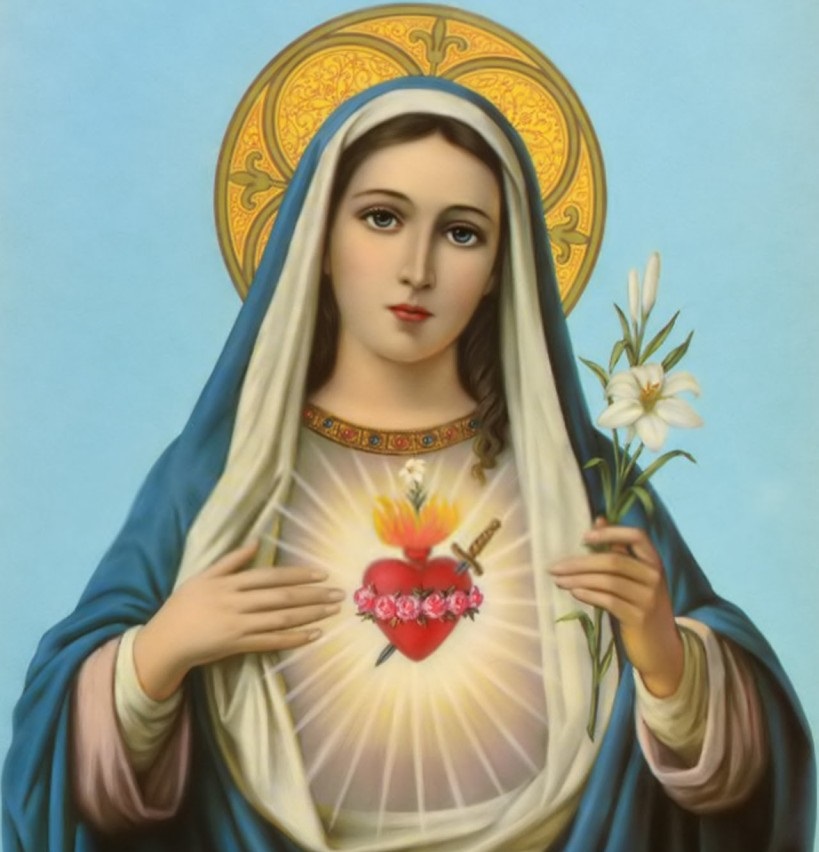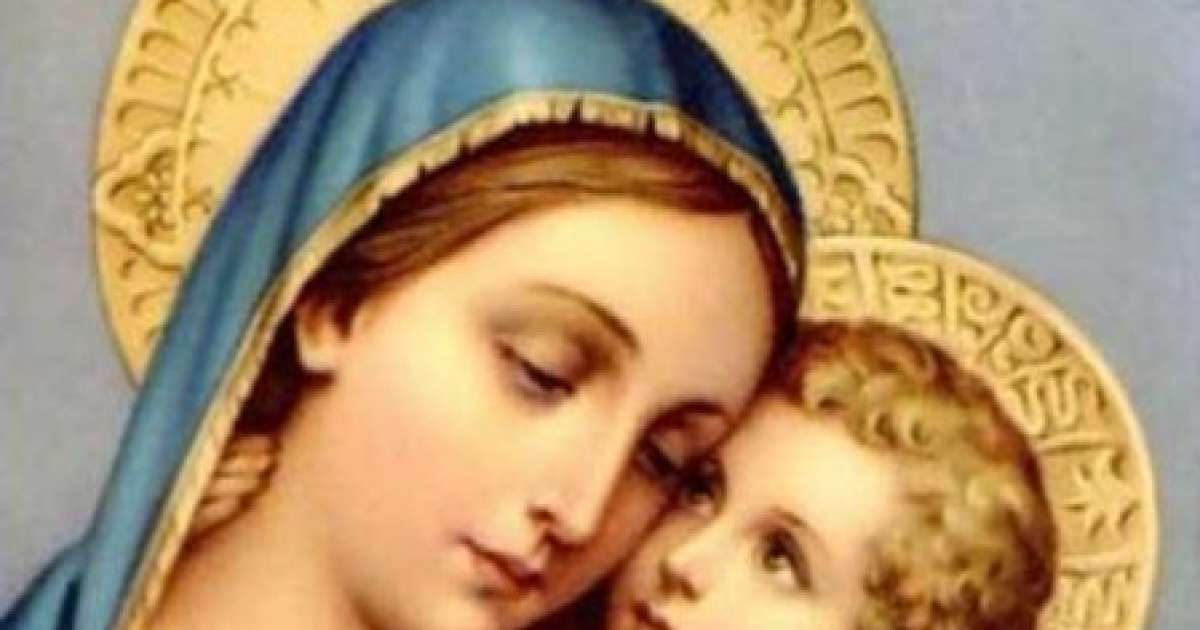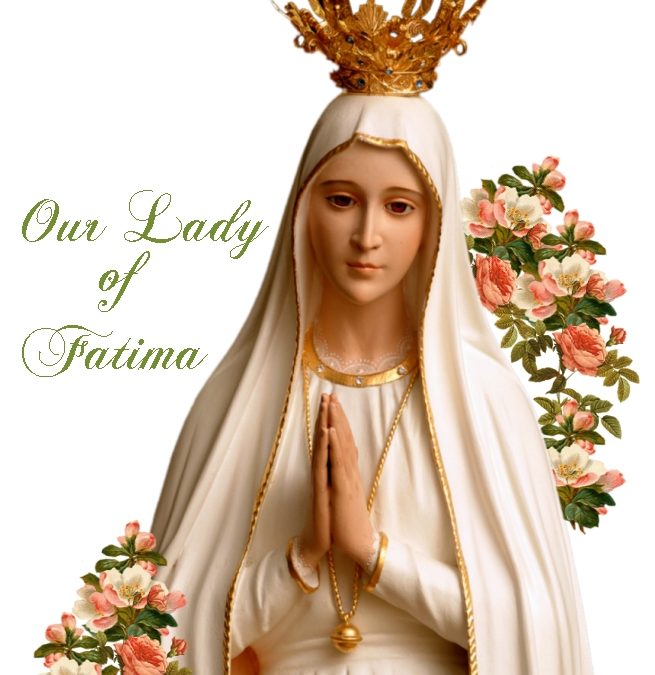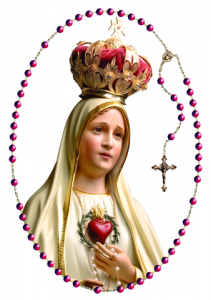

2017 MARIAN CONGRESS OF NIGERIA
A great sign appeared in the sky, a woman clothed with the sun, with the moon under her feet and on her head a crown of twelve stars
We welcome guests from all over the country and beyond to the 2017 Marian Congress taking place in the Catholic Archdiocese of Benin City, Edo State from 12th -14th October, 2017. We want to assure you that adequate preparations and arrangements have been put in place to host a successful congress. Once again welcome to Archdiocese of Benin City. Obokhian. Rev. Fr. Edwin Omorogbe Chairman. LOC

BRIEF HISTORY ABOUT OUR MOTHER MARY, THE BLESSED VIRGIN
Mary Mother of God, Pray for Us, Sinner now and the hour of our Death, Amen.
Mary, also known as St. Mary the Virgin, the Blessed Virgin Mary, Saint Mary, Mary Mother of God or the Virgin Mary is believed by many to be the greatest of all Christian saints. The Virgin Mother "was, after her Son, exalted by divine grace above all angels and men." Mary is venerated with a special cult, called by St. Thomas Aquinas, hyperdulia, as the holiest of all creatures. The main events of her life are celebrated as liturgical feasts of the universal Church. Mary's life and role in the history of salvation is foreshadowed in the Old Testament, while the events of her life are recorded in the New Testament. Traditionally, she was declared the daughter of Sts. Joachim and Anne. Born in Jerusalem, Mary was presented in the Temple and took a vow of virginity. Living in Nazareth, Mary was visited by the archangel Gabriel, who announced to her that she would become the Mother of Jesus, by the Holy Spirit. She became betrothed to St. Joseph and went to visit her cousin, Elizabeth, who was bearing St. John the Baptist. Acknowledged by Elizabeth as the Mother of God, Mary intoned the Magnificat. Mary is an intercessor, an advocate, obedient, observing, understanding, a mediator, trustworthy, a perfect icon of faith, ever faithful and believing and a mother that cares.

GET TO KNOW OUR MOTHER MARY BETTER
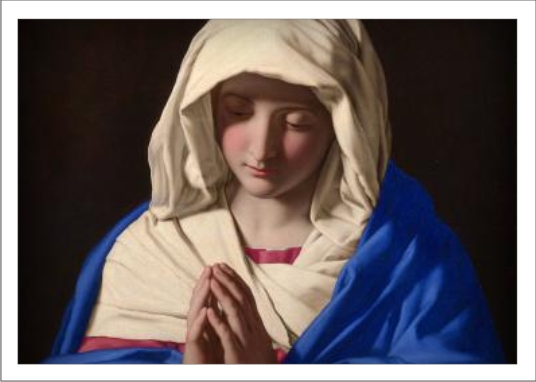

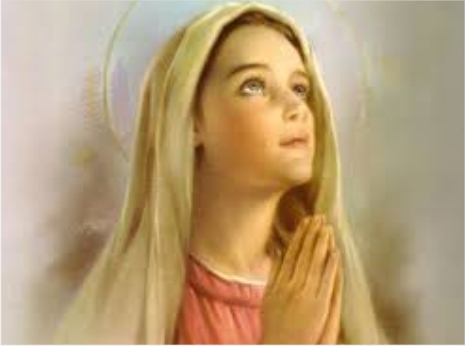
Pope Francis spoke to a gathering of priests, seminarians and religious women during his visit to Naples in March. In his speech, he told them that a key way to make sure Jesus is at the center of their lives is to “ask his mother to take you to him.” This is the role of Mary in the Church and in our own lives — for who is closer to the Son than his mother?
As the Church celebrates Mary throughout the month of May, this FAQ compiled by Dr. Robert Fastiggi, a professor of theology at Sacred Heart Major Seminary in Detroit and president of the Mariological Society of America, is designed to help readers more fully understand the Church’s teachings regarding the Virgin Mary and why she is truly the “cause of our joy
As Pope Francis said in Naples, “If you don’t love the mother, the mother will not give you the Son.”
Q: How can Catholics believe Mary was conceived without original sin when Romans 3:23 tells us that “all have sinned and are deprived of the glory of God”?
A: St. Paul is making a general statement about the condition of humanity after the fall. He does not intend to exclude exceptions to the “all” who have sinned, because Jesus never sinned nor did the good angels. In 1 Corinthians 4:5, St. Paul states that “everyone will receive praise from God.” Does this “everyone” include Satan, the demons and the damned? In fact, the Catholic dogma of Mary’s Immaculate Conception developed precisely because Mary is the mother of Jesus, who “has similarly been tested in every way, yet without sin” (Heb 4:15).
The dogma of Mary’s plenitude of grace from the moment of her conception finds support in the greeting of the angel in Luke 1:28. Mary is spoken of as “full of grace” (kekaritomene) which in Greek means one who has been and continues to be “favored” or “graced” by God (alternate translations could be “completely graced” or “thoroughly graced”). Since Jesus is fully human but without sin, it was necessary, then, that he take his human nature from one who is “full of grace” and thus free from all sin (original as well as personal sin).
In the 13th century, the Franciscan theologians William of Ware and Blessed John Duns Scotus developed the idea of “anticipatory redemption” or “pre-redemption.” The merits of Christ were applied to Mary in anticipation of her future role as the mother of the Word Incarnate. Thus, Mary was redeemed by Christ by being preserved from all stain of original sin. In 1854, Blessed Pius IX defined the doctrine of the Immaculate Conception as a truth revealed by God to be believed by all the faithful.
Q: Do Catholics worship Mary?
A: According to Catholic teaching, it is forbidden to worship any creature, and Mary is created by God — “For no creature could ever be counted as equal with the Incarnate Word and Redeemer” (Lumen Gentium, No. 62). The Second Council of Nicaea in 787 made a clear distinction between the worship due to God alone and the veneration or honor (often called dulia) that can be given to Mary, the angels, the saints and sacred images. Because Mary is the “Queen of the Saints” and the “Queen of the Angels,” she can be accorded high veneration (hyperdulia). Mary, though, can never receive the worship due to God alone.
When Emperor Augustus declared a census throughout the vast Roman Empire, Mary and St. Joseph went to Bethlehem, his city of lineage, as he belonged to the House of David. There Mary gave birth to Jesus and was visited by the Three Kings. Mary and Joseph presented Jesus in the Temple, where St. Simeon rejoiced and Mary received word of sorrows to come later. Warned to flee, St. Joseph and Mary went to Egypt to escape the wrath of King Herod. They remained in Egypt until King Herod died and then returned to Nazareth.
Nothing is known of Mary's life during the next years except for a visit to the Temple of Jerusalem, at which time Mary and Joseph sought the young Jesus, who was in the Temple with the learned elders.
The first recorded miracle of Jesus was performed at a wedding in Cana, and Mary was instrumental in calling Christ's attention to the need. Mary was present at the Crucifixion in Jerusalem, and there she was given into John the Apostle's care. She was also with the disciples in the days before the Pentecost, and it is believed that she was present at the resurrection and Ascension.
No scriptural reference concerns Mary's last years on earth. According to tradition, she went to Ephesus, where she experienced her "dormition." Another tradition states that she remained in Jerusalem. The belief that Mary's body was assumed into heaven is one of the oldest traditions of the Catholic Church.
Pope Pius XII declared this belief Catholic dogma in 1950. The four Catholic dogmas are: Mother of God, Perpetual virginity of Mary, the Immaculate Conception and Assumption of Mary. The feast of the Assumption is celebrated on August 15. The Assumption was the bodily taking up of the Virgin Mary into Heaven at the end of her earthly life. According to Pope Pius XII, the Virgin Mary "having completed the course of her earthly life, was assumed body and soul into heavenly glory."
In 1854, Pope Pius IX proclaimed the dogma of the Immaculate Conception - that Mary, as the Mother of the Second Person of the Holy Trinity, was free of original sin at the moment of her conception. The feast of the Immaculate Conception is celebrated on December 8. The birthday of Mary is an old feast in the Church, celebrated on September 8, since the seventh century.
Other feasts that commemorate events in the life of the Blessed Virgin Mary are listed in the Appendices. Pope Pius XII dedicated the entire human race to Mary in 1944. The Church has long taught that Mary is truly the Mother of God .

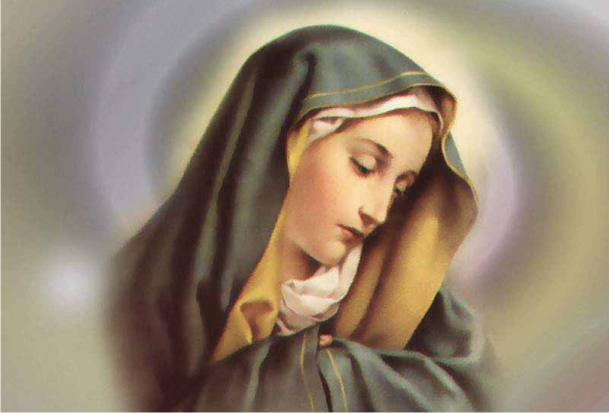
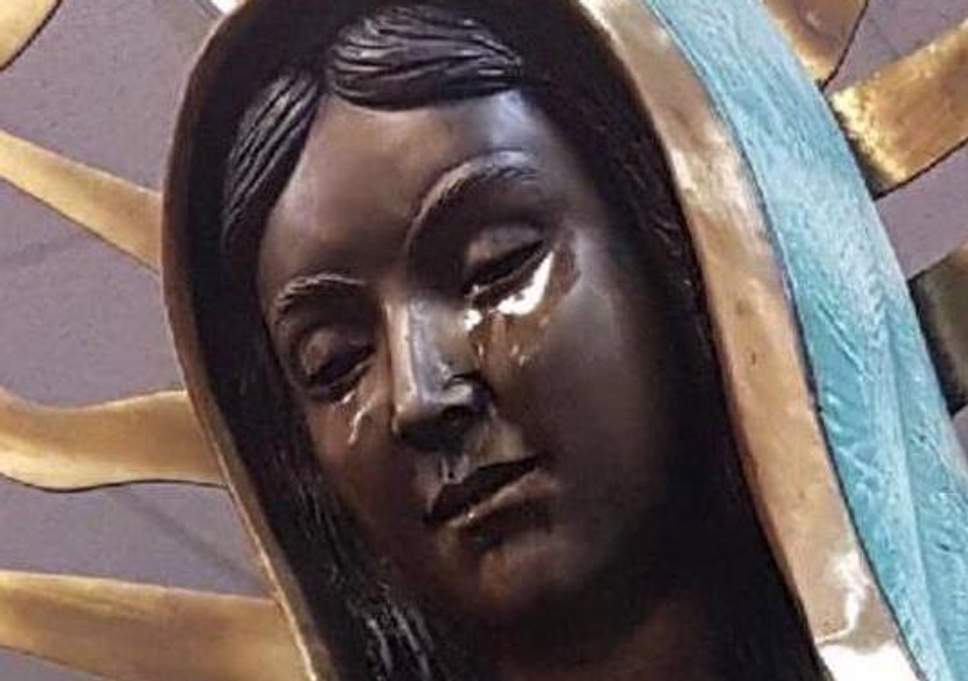
The Blessed Virgin Mary may be taken as a patroness of any good activity, for she is often cited as the patroness of all humanity. Mary is also associated with protecting many occupations and locations.
St. Paul observed that "God sent His Son, born of a woman," expressing the union of the human and the divine in Christ. As Christ possesses two natures, human and divine, Mary was the Mother of God in his human nature.
This special role of Mary in salvation history is clearly shown in the Gospel where she is seen constantly at her son's side during his soteriological mission. Because of this role, exemplified by her acceptance of Christ into her womb, her offering of him to God at the Temple, her urging him to perform his first miracle, and her standing at the foot of the Cross at Calvary Mary was joined fully in the sacrifice by Christ of himself.
Pope Benedict XV wrote in 1918: "To such an extent did Mary suffer and almost die with her suffering and dying Son; to such extent did she surrender her maternal rights over her Son for man's salvation, and immolated him - insofar as she could in order to appease the justice of God, that we might rightly say she redeemed the human race together with Christ."
Mary is entitled to the title of Queen because, as Pope Pius XII expressed it in a 1946 radio speech, "Jesus is King throughout all eternity by nature and by right of conquest: through him, with him, and subordinate to him, Mary is Queen by grace, by divine relationship, by right of conquest, and by singular election."
Mary possesses a unique relationship with all three Persons of the Trinity, thereby giving her claim to the title of Queen ship. She was chosen by God the Father to be the Mother of his Son; God the Holy Spirit chose her to be his virginal spouse for the Incarnation of the Son; and God the Son chose her to be his mother, the means of incarnating into the world for the purposes of the redemption of humanity.
This Queen is also our Mother. While she is not our Mother in the physical sense, she is called a spiritual mother, for she conceives, gives birth, and nurtures the spiritual lives of grace for each person. As Mediatrix of All Graces, she is ever present at the side of each person, giving nourishment and hope, from the moment of spiritual birth at Baptism to the moment of death.
In art, Mary is traditionally portrayed in blue. Her other attributes are a blue mantle, crown of 12 stars, pregnant woman, roses, and/or woman with child. Hundreds of thousands of pieces of Marian artwork and sculptures have been created over the years from the best and most brilliant artists, like Michelangelo and Botticell, to simple peasant artists. Some of the earliest examples of veneration of Mary is documented in the Catacombs of Rome. Catacomb paintings show Mary the Blessed Virgin with her son.
The confidence that each person should have in Mary was expressed by Pope Pius IX in the encyclical Ubipriinum: "The foundation of all our confidence . . . is found in the Blessed Virgin Mary. For God has committed to Mary the treasury of all good things, in order that everyone may know that through her are obtained every hope, every grace, and all salvation. For this is his will, that we obtain everything through Mary. “Through Mary our mother, we succeed.

MEANING OF BEING CONSECRATED TO THE IMMACULATE HEART OF MARY
By Professor Michael Ogunu
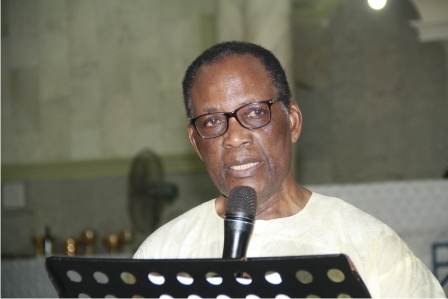
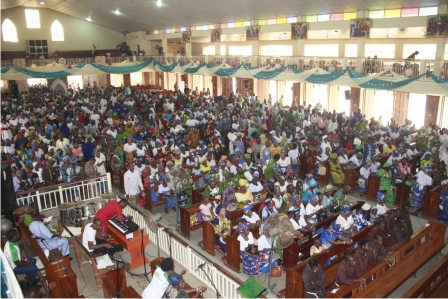

When one is consecrated, he or she is made sacred by being set aside for the service of God. To consecrate oneself to Mary means giving oneself to Jesus Christ through the Immaculate Heart of His Mother. We are all her spiritual children. As she once presented her Son Jesus in the Temple in the Spirit to the Father, so now, when we consecrate ourselves to Mary, we give ourselves totally to Mary; we recognize ourselves as her spiritual children and desire that she present us, united to her son Jesus in the Spirit to the Father. The spirit of Mary then lives within us and therefore the Holy Spirit dwells within us in a special way, as in a special temple.
“Consecration to the Mother of God”, says Pope Pius XII, “is a total gift of self, for the whole of life and for all eternity; and a gift which is not a mere formality or sentimentality, but effectual, comprising the full intensity of the Christian life - Marian life”. This consecration, the Pope explained, “tends essentially to union with Jesus, under the guidance of Mary”.
By our consecration we promise to become dependent on Mary in all things: to offer all our prayers and oblations to God through Mary, and to seek every gift from God through Mary. And we do this with the greatest confidence. Since she is our mother, she knows our needs better than we; and since she is Queen of Heaven, she has immediate access to the infinite treasury of graces in the Kingdom of her Divine Son.
Mary is not only the Mother of Jesus, Son of the Eternal Father; she is also Mother of all the Father's adopted children. As their Mother, she has been given the role of molding them into the likeness of Jesus.
Every work of grace, every increase of grace, is a work of the Holy Spirit; but as in the Incarnation of the Divine Word God used human instruments, so does He in the sanctification of each individual soul. As He chose Mary as the instrument through whom He would come to us, so He chose Mary as the instrument through whom we should go to Him. And both the mystery of God coming to us through Mary, and our being led to God through Mary, is a work of the Holy Spirit. So when we speak of Mary's unique role in our sanctification, she is but the instrument the Holy Spirit uses in sharing with us the divine life of grace. It is in this sense that Mary fashions us into the likeness of Christ.
However, that this transformation - through Mary's help - be accomplished in a notable degree, there must be an awareness of her role in our sanctification, a confidence in her maternal concern and in her power under God, a surrender of oneself into her hands, and a fervent, frequent and confident seeking of her aid. This usually comes through some form of consecration to the Mother of God.
As Fatima Our Lady asked for consecration to her Immaculate Heart, a consecration which, among other things, calls for the devotion of the Five First Saturdays, which includes the Rosary, meditation and Communions of reparation - all done in reparation to her Immaculate Heart. It involves a striving to fulfill her requests for prayer and sacrifices for the conversion of sinners and in reparation for offenses against the Divine Majesty. In a word, it involves a striving to fulfill all that she asked for at Fatima, and trying to bring others to heed her requests.
Consecration to Mary consists in an unconditional surrender to her of all we are and have in order to belong more perfectly to Jesus. This means that our thoughts, words, good works, prayers, joys, sorrows, graces possessions are given to Mary to deal with as she wills. Because she is our Mother and Queen, and because her will is one with Our Lord's, what we give to Mary, she gives to Him. God wishes that Mary be known and loved as Co-redemptrix, Advocate and Mediatrix before His throne because He finds it easier to grant graces through her, who is “full of graces”.
We are living in times where society has not only lost its sense of sin but it has exalted sin as something good and desirable. The threat for people, even Christians, not to know, love and serve God in this life so that they may live forever with Him in the next, is great if not greater than it has ever been in human history. Our first responsibility is to surrender ourselves completely to the Most Holy Trinity. We can do this through Mary by an act of total consecration to her Immaculate Heart. Then we must live out this consecration through prayer and action. We must also help bring as many souls as possible to God. We must share the simple but profound truths that Mary is our Mother, that she has special intercessory power for her children, that she is Spouse of the Holy Spirit, and that she has been chosen by Almighty God to bring her children into His very life.
On June 13th, 1917, Our Lady of Fatima said to Lucia: “Jesus wishes to use you in making me known and loved. He wishes to spread in the world the devotion to my Immaculate Heart. I promise salvation to those who embrace this devotion and those souls will be loved by God, like flowers placed by me to adorn His throne... My Immaculate Heart will be your refuge and the way that will lead you to God”. So, it will be for us too! Let us entrust ourselves and all we care for to the Immaculate Heart of Mary!
PRAYER FOR MARIAN YEAR IN NIGERIA 2017
Imprimatur
+Valerian M. Okeke
Archbishop of Onitsha
Chairman, Pastoral Affairs Department
Oh our lady, queen and mother of Nigeria we hail thee, we come to your throne of grace seeking your face in a special way in this year of our celebration of our national Marian year and centenary of Fatima. We come to you this year, mother of the holy family to intercede for our troubled families. We come to you, help of Christians, to intercede for the persecuted Christians in Nigeria we come to you our lady of perpetual help to intercede for our country and our leaders.
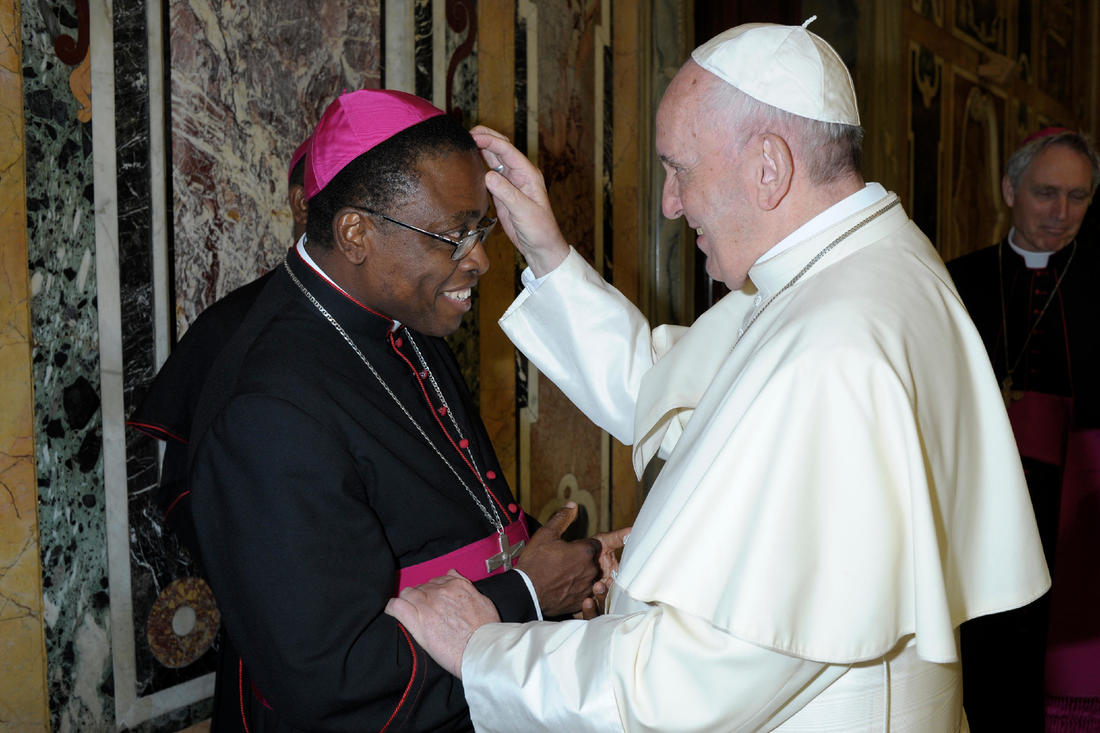
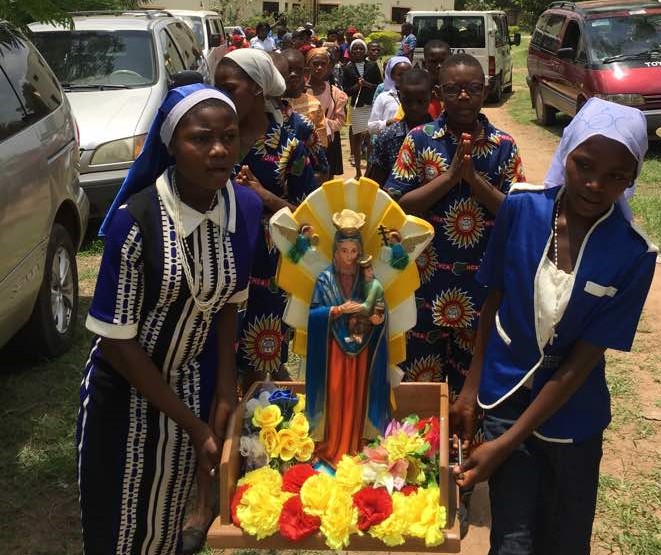
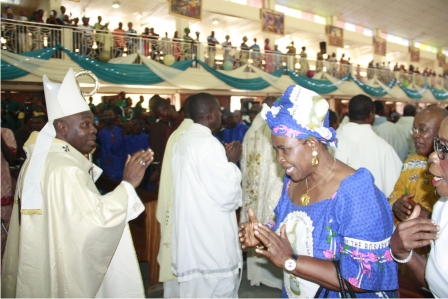
We come to you especially, our lady of Fatima in this centenary of your appearance in Portugal when you brought peace to that once troubled country and as we mark that historic moment this year. We beg of you to do the same in our country, Nigeria obtain for us that peace which can only come from heaven peace in our hearts, homes, places of work and our nation. May the celebration of the Marian year in Nigeria and the eventual re-consecration of our country to your immaculate heart, restore total peace.
Oh holy mother of god and mother of the church, with our hearts free from evil and hatred,
make us able to bring to all others true joy and peace, which come to us from your son, our lord Jesus Christ, who, with the father and the holy spirit, lives and reigns, forever and ever, Amen
WHY MARY IS HONORED ABOVE ALL WOMEN
Visitation of Our Blessed Mother to Elizabeth, the Child in her Womb leap for Joy: Elizabeth was filled with the Holy Spirit.
Why is Mary the only woman mentioned by name in the Quran? Why did GOD choose her and prefer her above all the women of creation (Qs 3:42)? No other prophet’s mother was given such an honor. What made this woman so special to GOD and the world?
God Chose Mary to Bring the Messiah into the World
God gave Mary great honor because of the glorious task he assigned to her. He chose her to bring the Messiah into the world. It was the most unusual and important mission ever given to a woman. She would be the mother of the Savior of the world. God's angel said to her, "O Mary! Allah gives you glad tidings of a Word from Him: his name is Christ Jesus, the son of Mary, held in honor in this world and the Hereafter and of those nearest to God"(Qs 3:45). Mary was given a great honor. But to her son belongs the greater honor. Her son, Jesus Christ, is in heaven and lives forever.
Catholics Do Not Worship Mary
Catholics do not worship Mary. We honor her just as God honored her. Mary did not die for the sins of the world. Mary cannot offer forgiveness for sin. Only Jesus, who came forth from her womb, can do these things. Only Jesus is worthy of worship.
Only Jesus Can Offer Salvation
It is said about Jesus, "He will save his people from their sins"(Matthew 1:21). He was called "Immanuel" which means "God with us" (Matthew 1:23). When the prophet John saw Christ Jesus coming toward him, he said, "Look, the lamb of God who takes away the sin of the world" (John 1:29). Only Jesus, God’s "Word" sent from heaven, and born to Mary without sin is called "a holy son" (Qs 19:19).
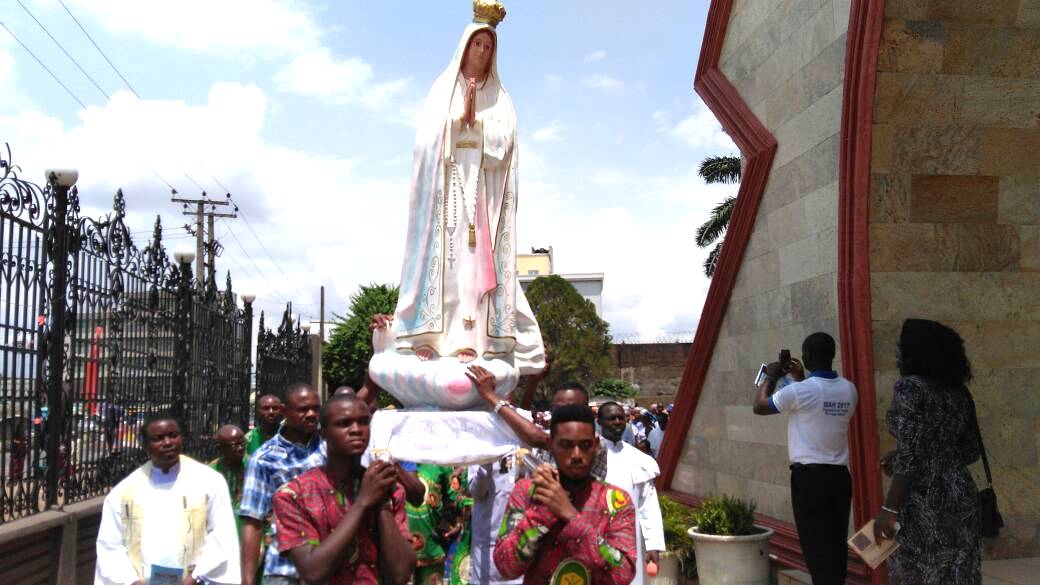

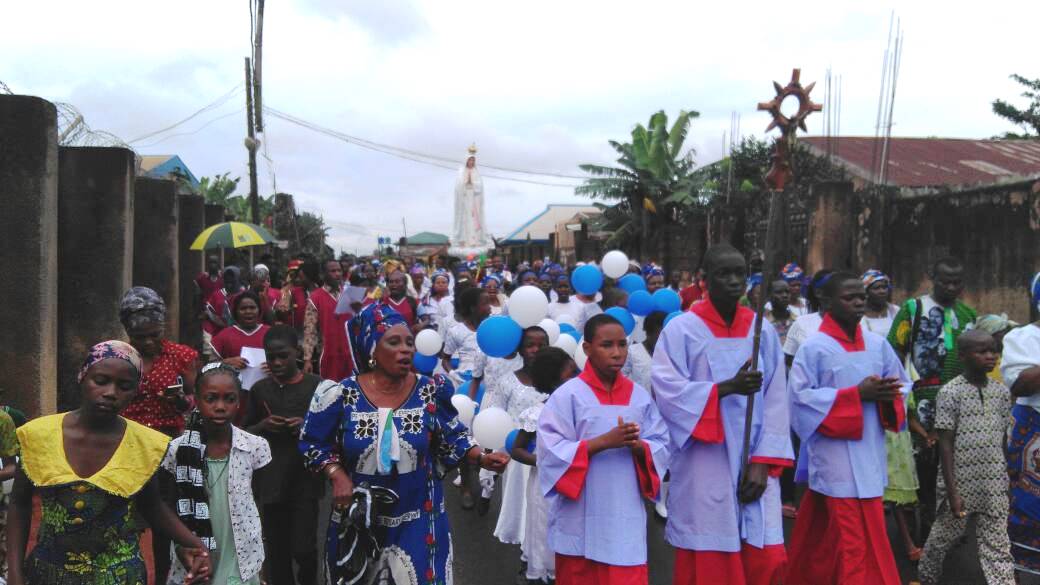
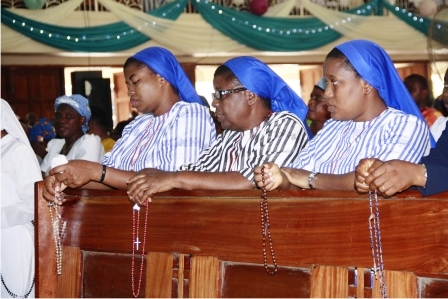
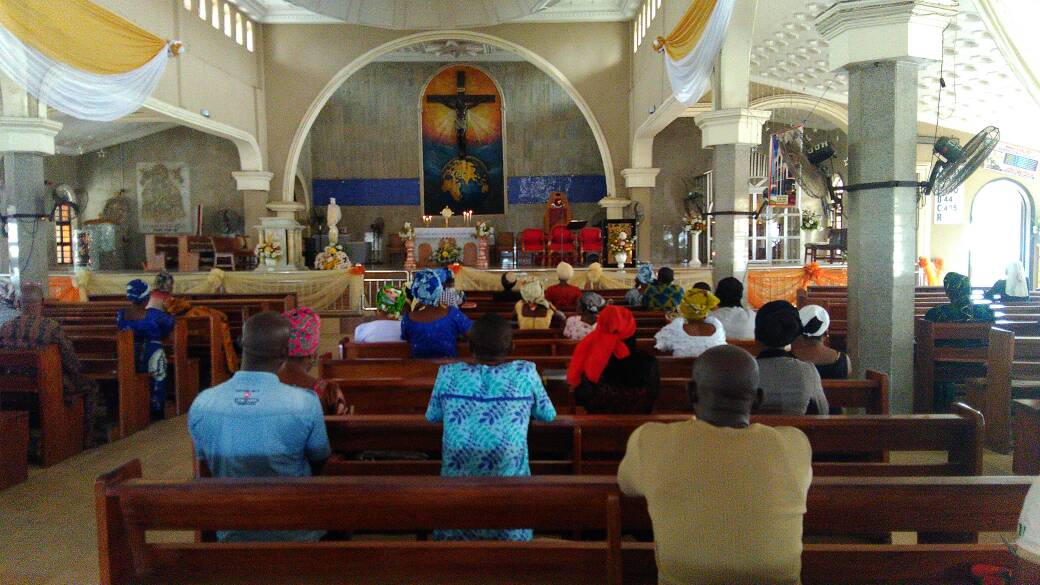
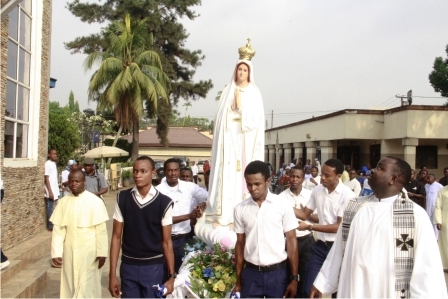
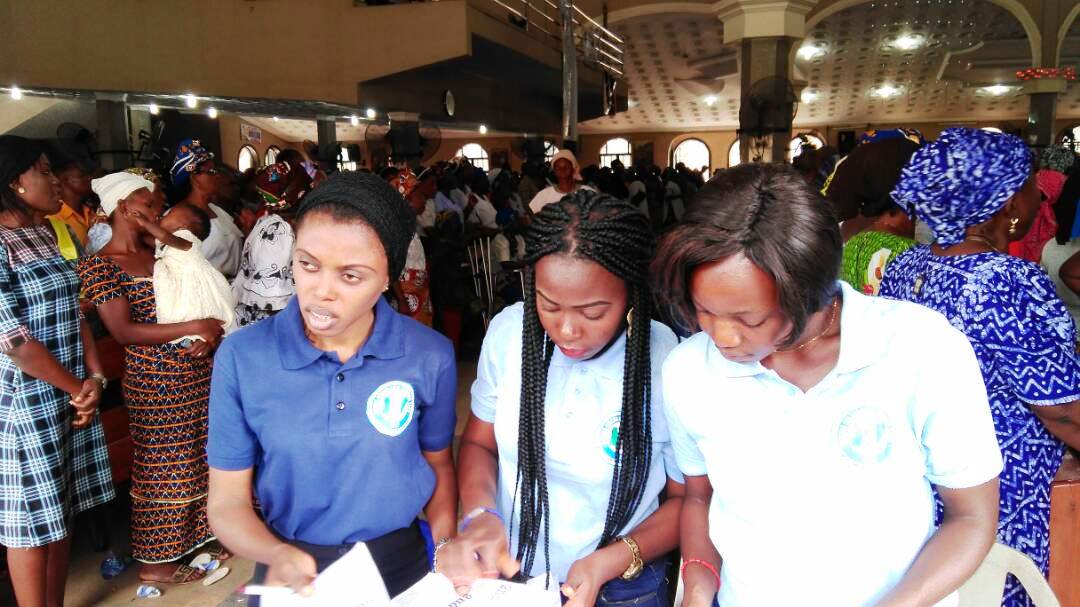
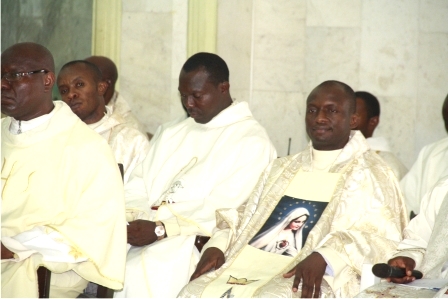
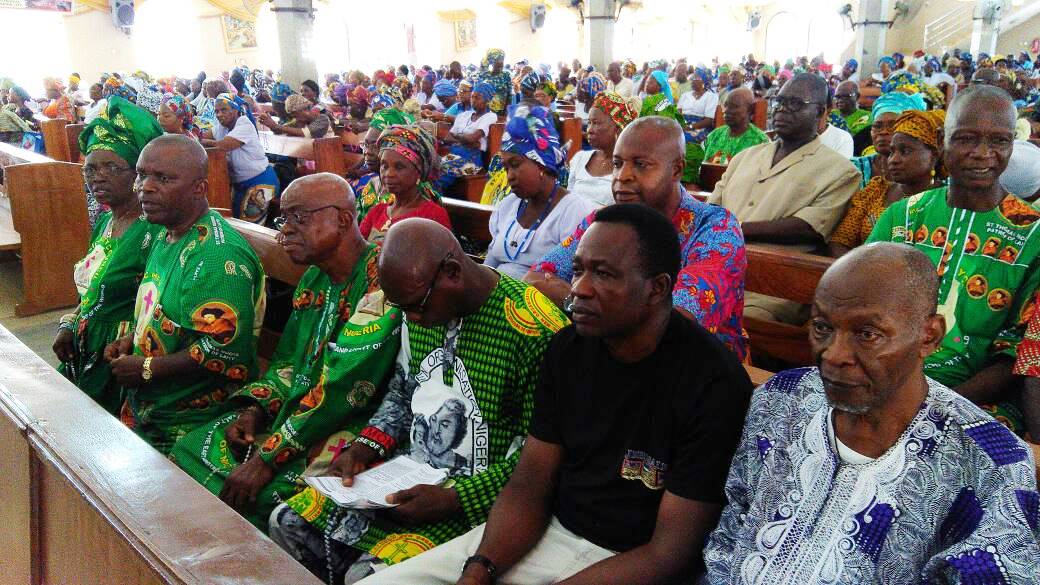

MARY, MODEL AND TEACHER OF FAITH
The Virgin Mary, “perfect icon of the faith,"
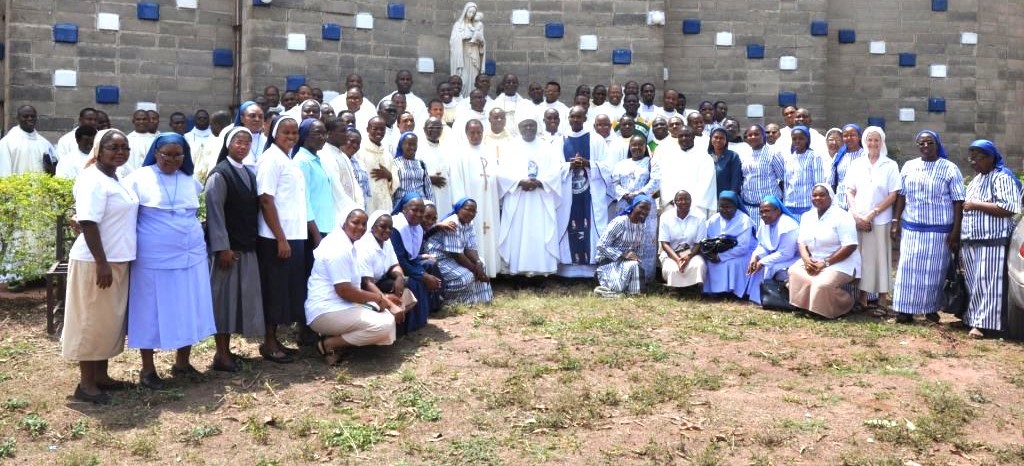
In many and various ways God spoke of old to our fathers by the prophets, but in these last days he has spoken to us by [his] Son.
When the fullness of time arrived, God sent forth his Son, born of woman, born under the law. All of the expectant waiting for the Savior's coming in the Old Testament was concentrated in our Lady's faith: “In Mary . . . is fulfilled the long history of faith of the Old Testament, with its account of so many faithful women, beginning with Sarah: women who, alongside the patriarchs, were those in whom God's promise was fulfilled and new life flowered." Like Abraham, “our father in faith," who left his homeland trusting in God's promise, Mary abandoned herself with complete trust in the Angel's announcement, thus becoming a model and mother for believers. The Virgin Mary, “perfect icon of the faith," believed that nothing is impossible for God, and thus made it possible for the Word to come to dwell among mankind.
Our Mother is a model of faith.
Our Mother is a model of faith. “By faith, Mary accepted the Angel's word and believed the message that she was to become the Mother of God in the obedience of her devotion (cf. Lk 1:38). Visiting Elizabeth, she raised her hymn of praise to the Most High for the marvels he worked in those who trust him (cf. Lk 1:46-55). With joy and trepidation she gave birth to her only son, keeping her virginity intact (cf. Lk 2:6-7). Trusting in Joseph, her husband, she took Jesus to Egypt to save him from Herod's persecution (cf. Mt 2:13-15). With the same faith, she followed the Lord in his preaching and remained with him all the way to Golgotha (cf. Jn 19:25-27). By faith, Mary tasted the fruits of Jesus' resurrection, and treasuring every memory in her heart (cf. Lk 2:19, 51), she passed them on to the Twelve assembled with her in the Upper Room to receive the Holy Spirit (cf. Acts 1:14; 2:1-4)."
Our Lady lived out her faith amid a fully human life, that of an ordinary woman. “[God] did not spare her pain, exhaustion in her work or trials of her faith. A village woman one day broke into praise for Jesus exclaiming: Blessed is the womb that bore you and the breasts that nourished you. Jesus said in reply: Rather, blessed are they who hear the word of God and keep it (Lk 11:27-28). It was a compliment to his Mother on her fiat (Lk I:38), her 'be it done.' She lived it sincerely, unstintingly, fulfilling its every consequence, but never amid fanfare, rather in the hidden and silent sacrifice of each day."
Our Lady “lived entirely from and in her relationship with the Lord; she was disposed to listen, alert to recognizing the signs of God in the journey of his people; she was integrated into a history of faith and hope in God's promises with which the fabric of her life was woven."
Teacher of faith
By faith, Mary penetrated into the Mystery of God One and Three in a way granted to no other creature. And as “mother of our faith," she has made us sharers in that knowledge. “We can never hope to fathom this inexpressible mystery; nor will we ever be able to give sufficient thanks to our Mother for bringing us into such intimacy with the Blessed Trinity."
Our Lady is Teacher of faith. Every aspect of faith in Christian life finds its prototype in Mary: being faithful to God and viewing the circumstances of ordinary life in the light of faith, even in moments of obscurity. Our Mother teaches us to be totally open to the divine will “even though it is mysterious, and often does not correspond with their own wishes, and is a sword that pierces their soul, as the elderly Simeon would say prophetically to Mary when Jesus was presented in the Temple (cf. Lk 2:35)." Her complete trust in God's faithfulness and in his promises never wavers, even when the Lord's words were difficult or apparently impossible to accept.
Therefore, “if our faith is weak, we should turn to Mary." Amid the darkness of the Cross, our Lady's faith and docility yields an unexpected fruit. “In the person of John, Christ is entrusting all men to his Mother, and especially his disciples: those who were to believe in him." Mary's motherhood extends to Christ's whole Mystical Body. Jesus gives us his Mother as our mother; he places us under her care, and offers us her intercession. Therefore the Church constantly invites the faithful to turn with particular devotion to Mary.
Our weakness is not an obstacle to grace. God takes it into account; that's why he has given us a mother. “In the struggle which the disciples must confront—all of us, all the disciples of Jesus, we must face this struggle—Mary does not leave them alone: the Mother of Christ and of the Church is always with us. She walks with us always, she is with us . . . Mary accompanies us, struggles with us, sustains Christians in their fight against the forces of evil."
In the school of faith, our Lady is the best teacher, for she always had an attitude of trust, of openness, of supernatural outlook, no matter what happened around her. Mary kept all these things, pondering them in her heart. “Let us try to imitate her, talking to our Lord, conversing like two people in love about everything that happens to us, even the most insignificant incidents. Nor should we forget that we have to weigh them, consider their value, and see them with the eyes of faith, in order to discover the Will of God."


 Mary's path of faith, although certainly different in many ways, is also similar to that of each one of us. Moments of bright light alternate with moments of darkness with respect to God's will. When they found Jesus in the Temple, Mary and Joseph did not understand the saying which he spoke to them. If, like our Lady, we welcome the gift of faith and place all our trust in God, we will confront each situation in our life cum gaudio et pace—with the joy and peace of God's children.
Mary's path of faith, although certainly different in many ways, is also similar to that of each one of us. Moments of bright light alternate with moments of darkness with respect to God's will. When they found Jesus in the Temple, Mary and Joseph did not understand the saying which he spoke to them. If, like our Lady, we welcome the gift of faith and place all our trust in God, we will confront each situation in our life cum gaudio et pace—with the joy and peace of God's children.
Imitating Mary's faith
In our Lady “the faith journey of the Old Testament was thus taken up into the following of Christ, transformed by him and entering into the gaze of the incarnate Son of God." In the Annunciation, Mary's response shows us her faith as a commitment, a self-giving, a vocation: Behold, I am the handmaid of the Lord; let it be to me according to your word. Like Mary Most Holy, Christians should live “with their eyes on God, repeating her words fiat mihi secundum verbum tuum . . . On these words depends the faithfulness to one's personal vocation—which is always unique and non transferable in each case—that will make us all cooperators in the work of salvation that God carries out in us and in the entire world."
But how can we always respond with a faith as firm as Mary's, never losing trust in God? By imitating her. When confronted by God's presence, Mary refuses to give in to fear or mistrust. Rather she “enters into a deep conversation with the Word of God that has been announced to her; she does not consider it superficially but meditates on it, lets it sink into her mind and her heart so as to understand what the Lord wants of her, the meaning of the announcement." Like our Lady, let us try to recognize God's will in all that happens in our lives. Mary reflects deeply and ponders on all the events in her life from the perspective only faith can give. With our Mother's help, let us strive to make this our response as well.
By contemplating Mary's life and imitating her, letting her lead us by the hand, we will be helped to stir up in those around us, in our relatives and friends, a greater openness to the light of faith. We will do so by the example of our consistent life, by our personal conversations, of friendship and trust, that include the necessary doctrine, to help facilitate a personal encounter with Christ through the sacraments and practices of piety, both when working and when resting. “If we become identified with Mary and imitate her virtues, we will be able to bring Christ to life, through grace, in the souls of many who will in turn become identified with him through the action of the Holy Spirit. If we imitate Mary, we will share in some way in her spiritual motherhood. And all this silently, like our Lady; without being noticed, almost without words, through the true and genuine witness of our lives as Christians, and the generosity of ceaselessly repeating her fiat, which we renew as an intimate link between ourselves and God."
Let us turn to Mary and ask her to help us live by faith and to recognize Jesus in our lives. We need a faith that assures us that nothing is comparable to the Love of God in which we have been made sharers; faith that nothing is impossible for those who work for and with Christ in his Church; faith that all men and women can convert to God; faith that despite our own wretchedness and falls we can be made whole again with God's help and that of those around us; faith in the means of holiness that God has given his Church, in the supernatural value of work and of little things; faith that we can redirect this world to God if we always hold onto his hand. In short, faith that God puts each of us in the best circumstances, whether of health or sickness, of working environment, etc., so that we can become saints, if we respond through our daily struggle.
“Christ lays down one condition: we must live by faith; then we will be able to move mountains. And so many things need moving... in the world, but, first of all, in our own hearts. So many obstacles placed in the way of grace! We have to have faith, therefore: faith and works, faith and sacrifice, faith and humility. For faith makes us all-powerful: If you will only believe, every gift you ask for in your prayer will be granted (Mt 21:22)."
Spurred by a strong faith, let us tell Jesus: “'Lord, I do believe, but help me to believe more and better!' Let us address this same plea to our Lady, Mother of God and our Mother, and Teacher of faith: Blessed art thou for thy believing; the message that was brought to thee from the Lord shall have fulfillment (Lk 1:45). “Mother, help our faith!"

Life of Mary: Wedding Feast at Cana
After spending many years in Nazareth, our Lord sets out to preach the coming of the Kingdom of God. All the evangelists report the first act in this new stage of Christ's life: his baptism by John the Baptist on the banks of the Jordan. But only St. John the Evangelist mentions our Lady's presence at the beginning of Jesus' public life: On the third day, a wedding feast took place in Cana of Galilee, and the Mother of Jesus was there. Jesus, too, and his disciples were invited to the wedding " (Jn 2:1-2).
There Jesus, at the request of his Mother, carries out his first miracle. A Jewish wedding feast usually lasted seven days, and in a small town like Cana, it is likely that everyone took part in the celebration, in one way or another. Jesus came accompanied by his first disciples. With so many people attending, it is not surprising that the wine ran short. Ever attentive to the needs of those around her, Mary was the first to realize it and told her Son: They have no wine (Jn 2:3). After his reply (which is not easy to interpret), Jesus complied with his Mother's request and performed a great miracle by converting water into wine.
But what John wishes to tell us does not end there. Writing his Gospel at the end of a long life and under the inspiration of the Holy Spirit, he would have meditated at length on Christ's miracles and teachings. Thus he brings out for us the deepest meaning of this first sign, as recent Popes have pointed out, in agreement with many christain faithfuls.
The Evangelist's chronological care in situating this event has a deep significance: According to the book of Exodus, the manifestation of God to Israel when establishing the Covenant took place three days after reaching Mount Sinai. Now, “the third day" since his return to Galilee in the company of his first disciples, Jesus is about to manifest his glory for the first time. Similarly, the full glorification of his Sacred Humanity will take place “on the third day" after his death, through the Resurrection.
Going beyond the historical fact of the wedding, John stresses that Mary's presence at the beginning and at the end of Jesus' public life corresponds to a divine plan. The name our Lord uses to address her in Cana (“woman," rather than “mother") seems to show his intention to form a family founded, not on the bonds of blood, but on faith. This is the same way God addressed Eve in Paradise, when promising that from her progeny would come the Redeemer (Gen 3:15). In Cana, Mary realizes that her maternal mission does not end on the natural plane: God is relying on her to be the spiritual Mother of his Son's disciples. Thanks to her intervention, the disciples' faith in the promised Messiah begins to grow. John himself states this at the end of his account: And so, it was in Cana of Galilee that Jesus performed the first of the signs by which he manifested his glory, and his disciples believed in him (Jn 2:11).
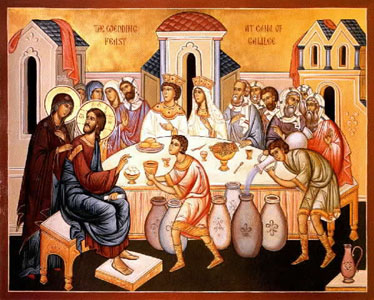
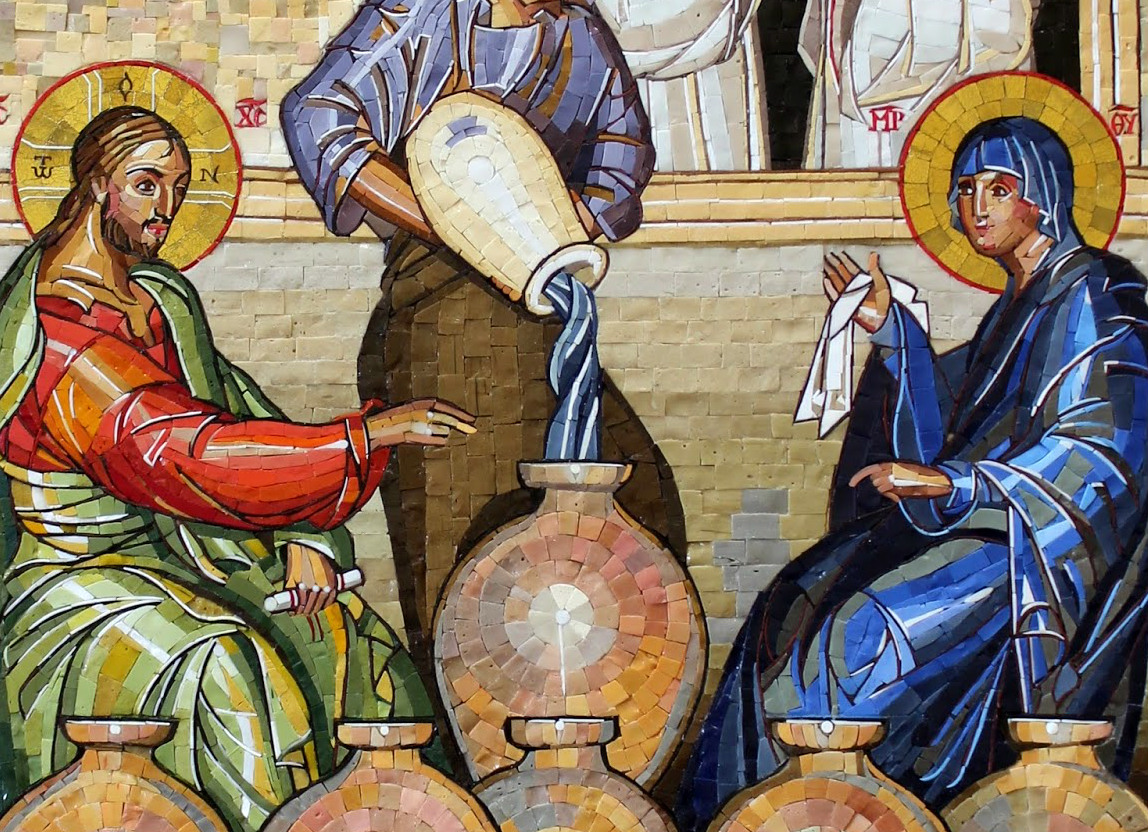
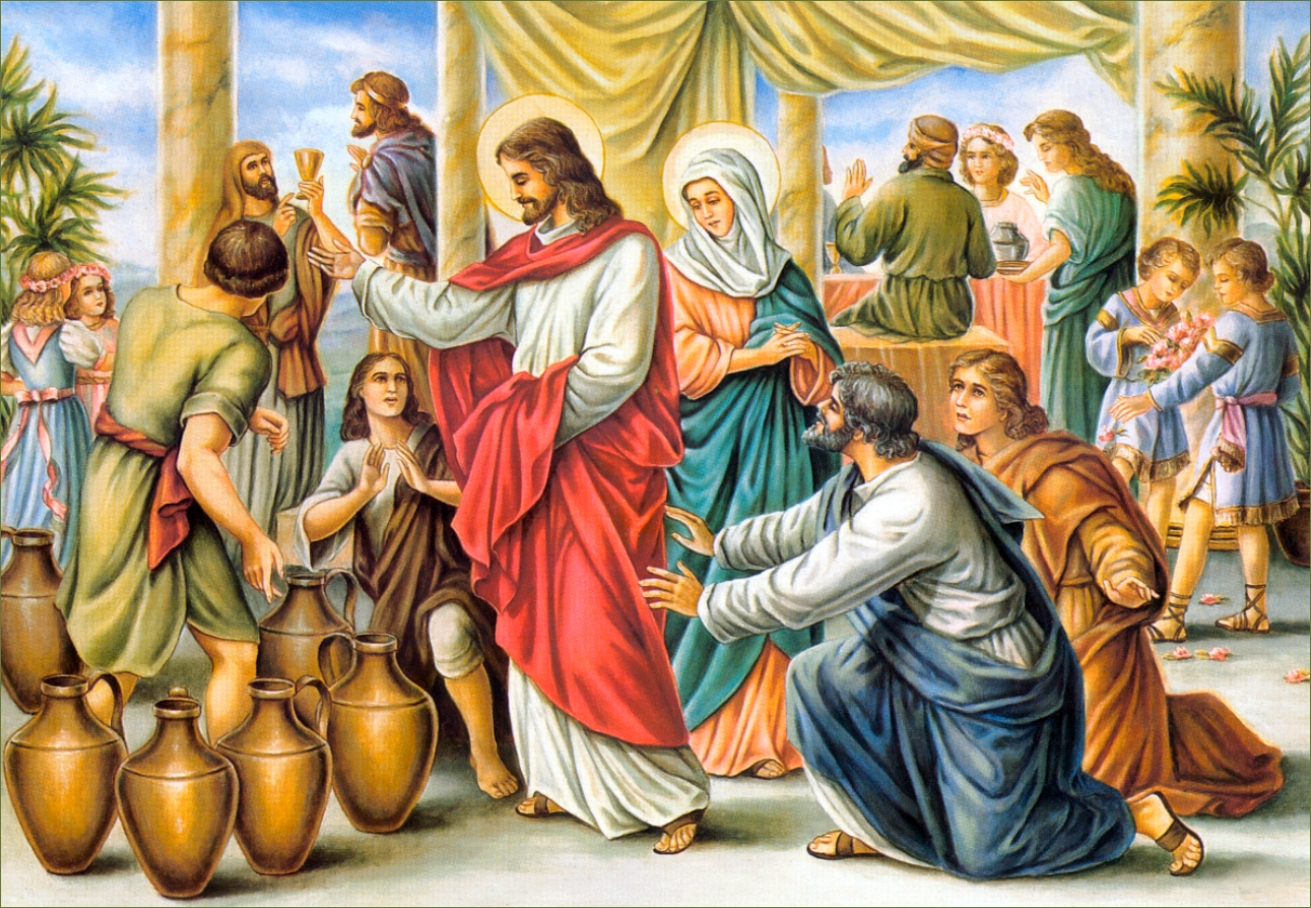
In Cana, Mary realizes that her maternal mission does not end on the natural plane: God is relying on her to be the spiritual Mother of his Son's disciples.
Most faithful say that this wedding feast is symbolic of the Word's union with mankind. As the prophets had announced: I will seal with you an eternal alliance … Nations that do not know you will run to you (Is 55:3, 5). The Fathers of the Church see in the water contained in the stone jars, prepared for the Jewish purifications (Jn 2:6), a symbol of the Old Law which Jesus is bringing to perfection through the New Law of the Spirit imprinted on hearts.
In the Old Testament, a New Covenant is promised for the messianic times, often with the image of a wedding feast, which will abound with every kind of good, especially wine. It is significant that, in John's account, wine is the main protagonist. It is mentioned five times, with the clear statement that the wine Jesus brings about by his power is better than the one that was beginning to run out (Jn 2:10). The quantity of water changed into wine (more than 130 gallons) is also remarkable. Such superabundance is typical of the messianic times.
Woman, what is that to you and to me? My hour has not yet come (Jn 2:4). Whatever the exact meaning of these words (which would have also been reflected in his tone of voice, the expression on his face, etc.), our Lady continues to trust her Son. Mary leaves the matter in his hands and directs the servants to do whatever he tells you (Jn 2:5)—her last recorded words in the Gospels.
That brief phrase recalls what the people of Israel told Moses when, on the Lord's behalf, he asked their consent to the Sinai Covenant: We will do all that the Lord has spoken (Ex 19:8). Those men and women were to be repeatedly unfaithful to the covenant with God. In contrast, the servants in Cana obeyed promptly and completely: Jesus said to them: 'Fill the jars with water.' And they filled them to the brim. Then he told them: 'Take them out now and bring them to the steward.' And they did (Jn 2:7-8).
Mary's trust inaugurates her Son's messianic mission. She precedes the disciples in faith, who come to believe in Jesus after the miracle occurs. Thus our Lady assists her Son in the first moment of the formation of Christ's new family. The Evangelist seems to suggest this when he brings his account to a close: After this he went down to Capharnaum with his Mother, his brethren, and his disciples, and they stayed there for some days (Jn 2:12). Everything is now ready for our Lord, by announcing the Good News through his words and deeds, to begin forming the new People of God, his Church.

CHRONOLOGY OF FATIMA
By
Prof. Michael Ogunu
Coordinator of the Fatima Apostolate in Africa
1. May 13, 1917 - First apparition of Our Lady to the three little shepherds in Fatima
2. October 13, 1917 – Last apparition of Our Lady to the three shepherds and the miracle of the sun
3. October 13, 1921 – Mass is allowed to be celebrated in the Chapel of the Apparitions for the first time.
4. October 13, 1930 – The Bishop of Leiria declares worthy of faith the apparitions and authorizes devotion to Our Lady of Fatima
5. May 13, 1931 –First consecration of Portugal to the Immaculate Heart of Mary, done by the Portuguese Episcopate according to the message of Fatima.
6. October 31, 1942 – Píus XII, speaking in Portuguese on the radio, consecrates the world to the Immaculate Heart of Mary, making veiled mention of Russia, following the request of Our Lady
7. May 13, 1946 – The statue of Our Lady of Fatima in the chapel is crowned by Cardinal Marsella, a pontifical delegate. The crown was offered by Portuguese women in thanksgiving for having freed Portugal from the Second World War.
8. May 13, 1967 – The Holy Father Paul VI travels to Fatima on the 50th anniversary of the first apparition to ask for world peace and unity of the Church
9. May 12-13, 1982 – The Holy Father John Paul II travels to Fatima as a pilgrim to thank Our Lady for having survived the brutal attempt on his life suffered exactly one year before in St. Peter’s Square. Kneeling, he consecrated the Church, humanity and peoples to the Immaculate Heart of Mary, making a veiled mention of Russia.
10. March 25, 1984 –In St. Peter’s Square, before the image of Our Lady, John Paul II again consecrates the world to the Immaculate Heart of Mary together with all the bishops of the world who had previously been notified to unite themselves with His Holiness in this consecration. Lucia later confirmed that this consecration satisfied the petition made by Our Lady.
11. May 12-13, 1991 – The Holy Father John Paul II returns to Fatima for the second time as a pilgrim on the 10th anniversary of the attempt on his life
12. May 13, 2000 – The Holy Father John Paul II, in his third visit to Fatima and before more than a million pilgrims beatifies Francisco and Jacinto and reveals the third part of the “secret of Fatima”. A historic moment of great transcendence. The Pope confirms one more time the importance of the messages and the heroic holiness of the visionary children. He presents them as very important examples of prayer, love and penance. He recognizes the transcendence of the messages the Virgin communicated to them.
13. October 8, 2000 – John Paul II made an unprecedented Act of Entrustment of the Third Millennium to the Immaculate Heart of Mary Most Holy at the Jubilee Mass celebrated by some 1,400 Bishops, their largest gathering in Rome since the Second Vatican Council, and in the presence of the Statue of Our Lady of Fatima that had been specially brought to St. Peter’s from the Sanctuary of Fatima.
14. May 2010 – Pope Benedict XVI visited the Shrine of Fatima and said that Fatima was an event “when heaven itself was opened over Portugal, like a window of hope that God opens when man closes the door to Him”.
15. May 13, 2013 – At his request, Pope Francis’ Pontificate was consecrated to Our Lady at Fatima by Cardinal Policarpo, Patriarch of Lisbon together with all the Bishops of Portugal.
16. October 12 & 13, 2013 – Our Lady’s Statue was brought to Fatima for the celebration of the Marian Day in the Year of Faith, when Pope Francis renewed the entrustment of the world to her Immaculate Heart, asking Mary’s help to “revive and grow faith”.
Our Lady Keeps Her Promise
